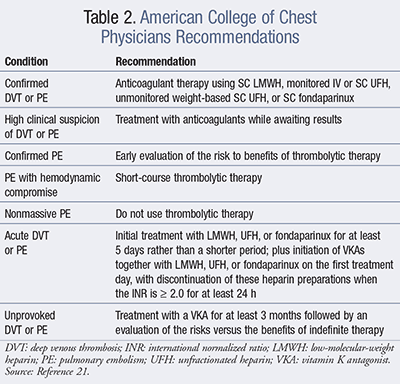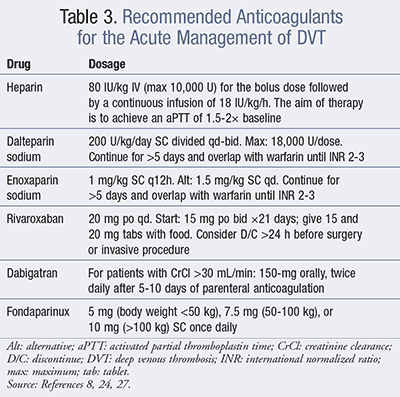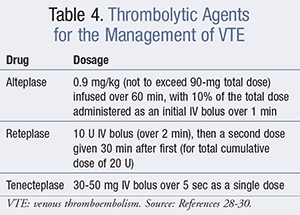US Pharm. 2014;39(7):39-42.
ABSTRACT: Deep venous thrombosis (DVT) can be precipitated by prolonged sitting during air travel. As the number of passengers traveling on long-haul flights continues to increase, so does the incidence of DVT. Various measures such as the use of compression hosiery can be prescribed as prophylaxis, particularly for at-risk patients. Those who do develop DVT should be treated using anticoagulant and possibly thrombolytic therapy. This article discusses the factors that increase a patient’s risk of developing DVT in flight, possible prophylactic measures that can be taken, and therapeutic strategies that are currently available in the U.S. market.
Venous thromboembolism (VTE) is a blood-clotting condition that encompasses two closely related disorders: deep venous (vein) thrombosis (DVT) and pulmonary embolism (PE). The link between VTE and extended periods of sitting has been recognized since World War II, when it was observed that prolonged cramped sitting in air-raid shelters during the 1940 London blitz resulted in many cases of PE.1 Most of the recent studies on air travel and VTE show that asymptomatic DVT is more common than symptomatic DVT or fatal PE.
Epidemiology
The first correlation between DVT and prolonged air travel was made by Homans in 1954.2 Quiet sitting for extended periods such as during long-distance air travel is now a well-known cause of VTE.3 Statistics show that about 2 billion people use commercial aircraft annually and that over 300 million of these people are on long-haul flights.4 The introduction of the Air Carrier Access Act of 1986 has allowed an increasing number of persons with medical disabilities to travel by air.5
The lack of consensus on the diagnostic tests or the limits on the time after landing to the development of DVT makes it difficult to obtain accurate data on the incidence of DVT. Estimates show that the occurrence in individuals traveling on flights for over 4 hours is about 1 in 4,656, and for those traveling for more than 8 hours is 1 in 200.6,7
Almost 30% of PE cases are fatal. This figure is elevated by the fact that there is a high rate of clinically unsuspected DVT and PE, which results in significant therapeutic and diagnostic delays.8
Presentation
Symptomatic DVT is characterized by swelling, pain, warmth, and redness in the involved extremity. However, in many cases, DVT associated with air travel may be asymptomatic. PE is most commonly associated with dyspnea, chest pain, tachypnea, syncope, and cough. In some cases, patients experience fever, hemoptysis, cyanosis, hypotension, and shock. Patients presenting to the pharmacy with any of the above symptoms following recent travel should be referred for further investigation.
Diagnostic Techniques
In suspected cases of PE, chest radiography, electrocardiography, pulse oximetry, and blood gas assays are usually performed as part of the pretest.9
Imaging Studies: The gold-standard diagnostic tests for PE and DVT are contrast venography (CV) and pulmo-nary angiography, respectively, even though both procedures are invasive and associated with a small but significant risk of complications.10 Newer strategies such as ultrasound for detecting DVT and ventilation perfusion (VQ) scanning for detecting PE have been proposed in an attempt to overcome the shortcomings of the invasive techniques.
Presently, more than 75% of patients with suspected DVT require repeated ultrasound tests to confirm findings, and a similar number of patients with suspected PE require imaging following a VQ scan.11 Since this proves inconvenient and costly for patients, one group developed a simple clinical model to calculate the pretest probability of DVT. The Wells Score System, as it is known, was found to reduce the rate of false-negative or false-positive ultrasound studies.11
Chest Radiography: While most chest radiographs are normal in patients with VTE, some patients may have an enlarged right descending pulmonary artery, decreased pulmonary vascularity ( Westermark sign), a wedge-shaped infiltrate, or an elevation of the hemidiaphragm (Hampton hump) .8
Doppler Ultrasonography: Doppler ultrasonography indicates the presence of a thrombus in a vein whereby the presence of internal echoes and a compressible vein are indicative of DVT.8 A negative Doppler ultrasonography result is not sufficient on its own to exclude the diagnosis of DVT.12 It is recommended that the patient’s D-dimer levels be checked and, if elevated, that the ultrasonography be repeated in another week.12 Ultrasonography unfortunately does not differentiate between old and new clots and has a lower sensitivity and specificity for venous thrombosis of the calf and upper extremity.9
Impedance Plethysmography: This technique measures the change in blood volume in the calf while a thigh cuff is inflated. Venous emptying of the leg is assessed by the rapidity of volume decrease whereby the slower the rate of emptying, the greater the obstruction. The sensitivity and specificity of this technique for DVT lie at 91% and 96%, respectively.13 Other conditions that restrict forward blood flow or result in hypotension or venous compression, such as preexisting venous disease, heart failure, or peripheral artery disease, may give false-positive results.8 Impedance plethysmography is of limited value when DVT is asymptomatic or distal.8
Contrast Venography: While contrast venography is the gold-standard test for DVT, it is not recommended in the initial evaluation due to its invasive nature.14 Furthermore, it is associated with technical difficulties and risks such as hematoma, pain, vessel damage, allergic reaction to contrast media, iatrogenic venous thrombosis, and tissue sloughing from contrast extravasation. It is therefore reserved for patients who are highly likely to have DVT but have negative noninvasive results, or when a noninvasive test cannot be performed.14
Laboratory Studies (Plasma D-Dimers): Plasma D-dimers are the most recent addition to the noninvasive tests for VTE; they were developed with the goal of being a one-step test that has a sensitivity and negative predictive value of 100% .10 They are a product of fibrin degradation, detectable in the blood after a blood clot is degraded by fibrinolysis. D-dimer assays are fast, accurate, and readily available but vary in their sensitivity and specificity.15
While D-dimer assays have a high negative predictive value of around 94%, a positive result is not diagnostic since a number of conditions, such as impaired renal function, ongoing blood loss, pregnancy, and atrial fibrillation, can cause D-dimer levels to rise.9 In addition, an electrocardiography may be performed to rule out a myocardial infarction and an echocardiography done to detect any signs of right-sided heart strain.8
Risk Factors and Prevention
Prolonged sitting in a crowded condition, hypoxia in the cabin, and dehydration are all risk factors for DVT in flight.4 ,16 There are additional patient-specific factors that can add to this risk. All patients should be advised to:
- Do frequent lower leg exercises
- Move/rise from the seat on a regular basis, if practical
- Maintain adequate hydration
- Minimize alcohol intake
- Avoid sedative medications.
Further patient-specific measures may be required depending upon whether a person is at low, intermediate, or high risk.4 TABLE 1 lists the recommended prophylactic measures for each risk group.4 ,17

Compression Stockings: The LONFLIT study demonstrated the usefulness of compression stockings in patients traveling on long-haul flights.18 Compression stockings improve blood flow by applying a gentle pressure around the ankle. The pressure combined with regular movement of the legs allows the blood in the superficial veins to move to the deep veins and back to the heart. The stockings should be well fitted and sit well below the knee. The ideal pressure at the ankle should be 15 to 30 mmHg.19
It has been shown that compression stockings largely reduce symptomless DVT in air travel passengers.20 Furthermore, the passengers wearing compression stockings experienced less discomfort and swelling in their legs than those who did not wear them.
Pharmacologic Measures
While the American Academy of Chest Physicians advises against the use of pharmacologic prophylaxis of VTE during long-distance travel, antiplatelet drugs or anticoagulants may sometimes be prescribed.19 Anticoagulants such as low-molecular-weight heparins (LMWHs) appear to be more effective than antiplatelet drugs such as aspirin.17 However, the risks of bleeding need to be outweighed against the benefits of pharmacologic prophylaxis in these patients.
Treatment of VTE
There are two pharmacologic options for the treatment of VTE: anticoagulant therapy and thrombolytic therapy. In more severe cases, surgical options including thrombectomy and venous interruption may be required. The recommendations by the American College of Chest Physicians are summarized in TABLE 2.21

Anticoagulant Therapy: Anticoagulant therapy prevents the deposition of further clots and allows an existing clot to disintegrate.22 Anticoagulants exert their effects through their action on the coagulation cascade. Anticoagulants, particularly warfarin, should be used with caution since they have a narrow therapeutic index and a high number of drug interactions.
Heparin is an acid glycosaminoglycan that is prescribed as first-line anticoagulant therapy.23 Since it works by augmenting the activity of antithrombin III and preventing the conversion of fibrinogen to fibrin, it cannot lyse an existing clot but can prevent further thrombogenesis. An initial bolus dose of 80 mg/kg is followed by a continuous infusion of 18 mg/kg/h. The aim of therapy is to achieve an activated partial thromboplastin time ( aPTT) of 1.5 to 2 times baseline. Heparin therapy is followed by a longer course of warfarin sodium.23
Warfarin exerts its effect by blocking the synthesis of vitamin K–dependent coagulation factors in the liver. The dose of warfarin should be tailored to maintain an international normalized ratio (INR) of 2.0 to 3.0. It is recommended that warfarin therapy be administered for a minimum of 3 months.24
Other anticoagulants that may be used in the acute management of DVT include enoxaparin, dalteparin, and rivaroxaban. Enoxaparin and dalteparin work by enhancing the inhibition of factor Xa and thrombin by increasing antithrombin III activity. They are both administered for 7 to 14 days, followed by maintenance therapy with warfarin. Rivaroxaban is an oral factor Xa inhibitor that inhibits platelet activation by selectively blocking the active site of factor Xa without requiring a cofactor for its activity. More recently the direct thrombin inhibitor dabigatran and the factor Xa inhibitor fondaparinux have been approved by the FDA for the treatment and reduction in the risk of recurrence of DVT and PE.25 ,26 The recommended doses of these anticoagulants are listed in TABLE 3.8,24,27

Thrombolytic Therapy: Thrombolytic agents exert their effect by activating plasminogen to plasmin. Plasmin degrades fibrin to soluble peptides when it comes into contact with a thrombus or a hemostatic plug. Alteplase, tenecteplase, and reteplase are the thrombolytic agents currently approved for the management of VTE. They are administered via IV and have an immediate onset of action.23 However, the manufacturer indicates that the treatment of PE with alteplase has not been shown to constitute adequate clinical treatment of underlying DVT. The manufacturer states that the possible risk of reembolization due to the lysis of underlying DVT should be considered.28 The recommended doses of these drugs are listed in TABLE 4.28-30
There are a number of contraindications to the use of thrombolytic therapy. Absolute contraindications include recent bleeding, a history of hemorrhagic stroke, intracranial or intraspinal disease, and pregnancy.8 The relative contraindications to thrombolytic therapy include major surgery or trauma within the last 2 weeks; biopsy within 10 days; invasive procedures or procedures in a location inaccessible to external compression; uncontrolled coagulation defects such as thrombocytopenia; and nonhemorrhagic stroke.8

Role of the Pharmacist
Patients often come into pharmacies to inquire about travel vaccines and antimalarials, buy travel-size toiletries, and even refill long-term prescriptions just before their trip. This is an excellent opportunity for pharmacists to identify patients who are at a higher risk of developing DVT when traveling on long-distance flights and to counsel them appropriately. All patients should be advised to keep moving their leg muscles, walk along the aisle when possible, and stay hydrated during their flight. Additionally, at-risk patients should be measured and fitted for compression stockings to improve blood circulation. Lastly, pharmacists should take the opportunity to counsel their patients on the correct use of anticoagulants and thrombolytics, if prescribed.
REFERENCES
1. Simpson K. Shelter deaths from pulmonary embolism. Lancet. 1940;ii
:744.
2.
Homans J. Thrombosis of the deep leg veins due to prolonged sitting. N
Eng J Med. 1954
;250:148-149.
3.
Arfvidsson B,
Eklof B,
Kistner RL, et al. Risk factors for venous thromboembolism following prolonged air travel.
Coach class thrombosis.
Hematol
Oncol Clin North Am. 2000
;14(2):391-400.
4.
Gavish I, Brenner B. Air travel and the risk of thromboembolism. Intern
Emerg Med. 2011
;6(2):113-116.
5. Air Carrier Access Act, 49 USC §41705 (1986).
6.
Kesteven PL. Traveller’s thrombosis.
Thorax. 2000
;55(suppl 1):S32-S36.
7. Hughes G. Question from practice: Do you give up-to-date advice on how to prevent “economy class syndrome”? Pharmaceutical J. 2013
;290:744.
8. Palo VA. Thromboembolism. Medscape Reference.
http://emedicine.medscape.com/article/1267714-overview#aw2aab6b2b6. Accessed March 15, 2014.
9. Wilbur J,
Shian B. Diagnosis of deep venous thrombosis and pulmonary embolism.
Am
Fam Physician. 2012
;86(10):913-919.
10. Kelly J, Rudd A, Lewis RR, Hunt BJ.
Plasma D-dimers in the diagnosis of venous thromboembolism. Arch Intern Med. 2002
;162(7):747-756.
11. Wells PS, Anderson DR,
Bormanis J, et al. Value of assessment of pretest probability of deep-vein thrombosis in clinical management. Lancet.
1997; 350:1795-1798.
12. Johnson SA, Stevens SM,
Woller SC, et al. Risk of deep vein thrombosis following a single negative whole-leg compression ultrasound: a systematic review and meta-analysis. JAMA. 2010
;303(5):438-445.
13. Hull RD, Hirsh J, Carter CJ, et al. Diagnostic efficacy of impedance
plethysmography for clinically suspected deep-vein thrombosis.
A randomized trial. Ann Intern Med. 1985
;102(1):21-28.
14.
Kearon C, Julian JA, Newman TE, Ginsberg JS.
Noninvasive diagnosis of deep venous thrombosis.
McMaster Diagnostic Imaging Practice Guidelines Initiative. Ann Intern Med. 1998
;128(8):663-677.
15. Stein PD, Hull RD, Patel KC, et al. D-dimer for the exclusion of acute venous thrombosis and pulmonary embolism: a systematic review. Ann Intern Med. 2004
;140(8):589-602.
16.
Chee YL, Watson HG.
Air travel and thrombosis.
Br J
Haematol. 2005
;130(5):671-680.
17. Watson HG,
Baglin TP. Guidelines on travel-related venous thrombosis.
Brit J
Haematol. 2011
;152:31-34.
18.
Belcaro G,
Geroulakos G,
Nicolaides AN, et al. Venous thromboembolism from air travel: the LONFLIT study. Angiology. 2001
;52(6): 369-374.
19. Kahn SR, Lim W, Dunn AS, et al. Prevention of VTE in nonsurgical patients: Antithrombotic Therapy and Prevention of Thrombosis, 9th
ed: American College of Chest Physicians Evidence-Based Clinical Practice Guidelines. Chest. 2012
;141(2 suppl):e195S-e226S.
20. Clarke MJ, Hopewell S,
Juszczak E, et al. Compression stockings for preventing deep vein thrombosis in airline passengers. Cochrane Database
Syst Rev. 2006;(2)
:CD004002.
21.
Kearon C, Kahn SR,
Agnelli G, et al; American College of Chest Physicians. Antithrombotic therapy for venous thromboembolic disease: American College of Chest Physicians Evidence-Based Clinical Practice Guidelines (8th
ed). Chest. 2008
;133(6 suppl):454S-545S.
22. Bauer KA. New anticoagulants.
Curr
Opin
Hematol. 2008
;15(5): 509-515.
23.
Hyers TM,
Agnelli G, Hull RD, et al. Antithrombotic therapy for venous thromboembolic disease. Chest. 2001
;119(1 suppl):176S-193S.
24.
Guyatt GH,
Akl EA,
Crowther M, et al. Executive summary: Antithrombotic therapy and prevention of thrombosis, 9th
ed: American College of Chest Physicians Evidence-Based Clinical Practice Guidelines. Chest. 2012; 141(2 suppl)
:7S-47S.
25.
Pradaxa (
dabigatran) prescribing information. Ridgefield, CT:
Boehringer
Ingelheim Pharmaceuticals,
Inc; April 2014.
26.
Arixtra (
fondaparinux) prescribing information. Research Triangle Park, NC: GlaxoSmithKline; September 2013.
27.
Xarelto (
rivaroxaban) prescribing information. Titusville, NJ: Janssen Pharmaceuticals,
Inc; March 2014.
28.
Activase (
alteplase) dosing and administration.
www.activase.com/iscstroke/dosing-and-administration. Accessed March 27, 2014.
29.
Retavase (
reteplase) product monograph.
www.vidyya.com/2pdfs/retavase.pdf. Accessed May 12, 2014.
30.
TNKase (
tenecteplase) prescribing information. South San Francisco, CA: Genentech,
Inc;
May 2011.
To comment on this article, contact rdavidson@uspharmacist.com.





